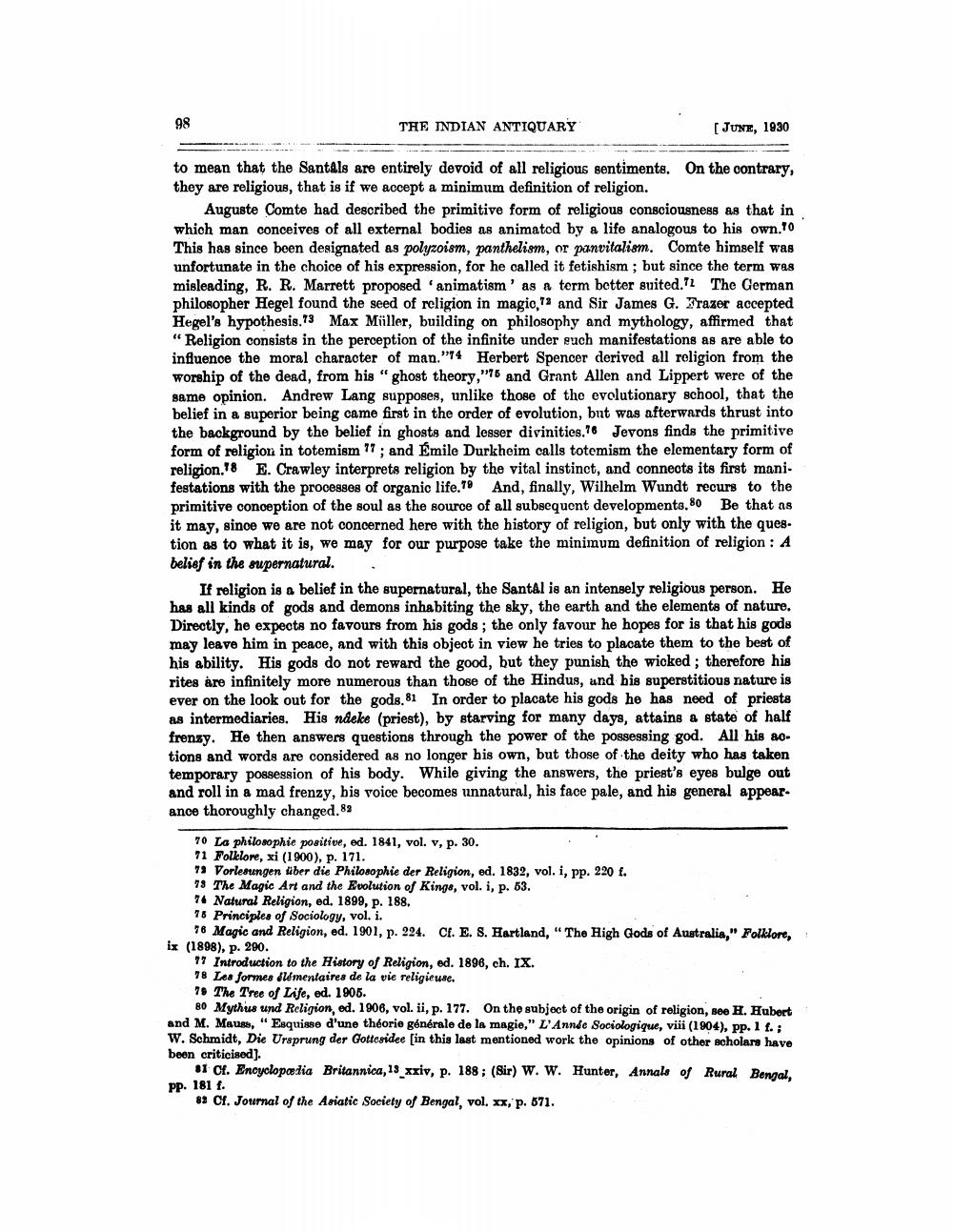________________
THE INDIAN ANTIQUARY
[JUNE, 1930
to mean that the SantAls are entirely devoid of all religious sentiments. On the contrary, they are religious, that is if we accept a minimum definition of religion.
Auguste Comte had described the primitive form of religious consciousness as that in which man conceives of all external bodies as animated by a life analogous to his own." This has since been designated as polyzoism, pantheliom, or panvitalism. Comte himself was unfortunate in the choice of his expression, for he called it fetishism ; but since the term was misleading, R. R. Marrett proposed animatism' as a term better suited. The German philosopher Hegel found the seed of religion in magic, and Sir James G. Frazer accepted Hegel's hypothesis.73 Max Müller, building on philosophy and mythology, affirmed that "Religion consists in the perception of the infinite under guch manifestations as are able to influence the moral character of man."74 Herbert Spencer derived all religion from the worship of the dead, from his "ghost theory,"76 and Grant Allen and Lippert were of the same opinion. Andrew Lang supposes, unlike those of the evolutionary school, that the belief in a superior being came first in the order of evolution, but was afterwards thrust into the background by the belief in ghosts and lesser divinities.76 Jevons finds the primitive form of religion in totemism "7; and Emile Durkheim calls totemism the elementary form of religion.T8 E. Crawley interprets religion by the vital instinct, and connects its first mani. festations with the processes of organic life.79 And, finally, Wilhelm Wundt recurs to the primitive conception of the soul as the source of all subsequent developments.80 Be that as it may, since we are not concerned here with the history of religion, but only with the ques. tion as to what it is, we may for our purpose take the minimum definition of religion : A belief in the supernatural. .
If religion is a belief in the supernatural, the Santal is an intensely religious person. He has all kinds of gods and demons inhabiting the sky, the earth and the elements of nature. Directly, he expects no favours from his gods; the only favour he hopes for is that his gods may leave him in peace, and with this object in view he tries to placate them to the best of his ability. His gods do not reward the good, but they punish the wicked; therefore his rites are infinitely more numerous than those of the Hindus, and his superstitious nature is ever on the look out for the gods. 81 In order to placate his gods he has need of priests as intermediaries. His ndeke (priest), by starving for many days, attains a state of half frenzy. He then answers questions through the power of the possessing god. All his aotions and words are considered as no longer his own, but those of the deity who has taken temporary possession of his body. While giving the answers, the priest's eyes bulge out and roll in a mad frenzy, bis voice becomes unnatural, his face pale, and his general appear. ance thoroughly changed. 89
70 La philosophie positive, ed. 1841, vol. v, p. 30. 71 Folklore, xi (1900), p. 171. 71 Vorlesungen über die Philosophie der Religion, ed. 1832, vol. I, pp. 220 f. 78 The Magic Art and the Evolution of Kinga, vol. i, p. 63. 74 Natural Religion, ed. 1899, p. 188. 76 Principles of Sociology, vol. i.
76 Magic and Religion, ed. 1901, p. 224. Cf. E. S. Hartland, "The High Gods of Australia," Folklore, ix (1898), p. 290.
77 Introduction to the History of Religion, ed. 1896, ch. IX. 78 Les formes dlémentaires de la vie religieuse. 79 The Tree of Life, ed. 1905.
80 Myths und Religion, ed. 1906, vol. ii, p. 177. On the subject of the origin of religion, see H. Hubert and M. Maun, "Esquisse d'une théorie générale de la magie," L'Annde Sociologique, viii (1904), pp. 1 f. ; W. Schmidt, Die Ursprung der Gottesidee [in this last mentioned work the opinions of other scholars have been criticised).
11 Cf. Encyclopaedia Britannica, 13 xxiv, p. 188; (Sir) W. W. Hunter, Annals of Rural Bengal, Pp. 181 f.
83 Cf. Journal of the Asiatic Society of Bengal, vol. xx, p. 671.




